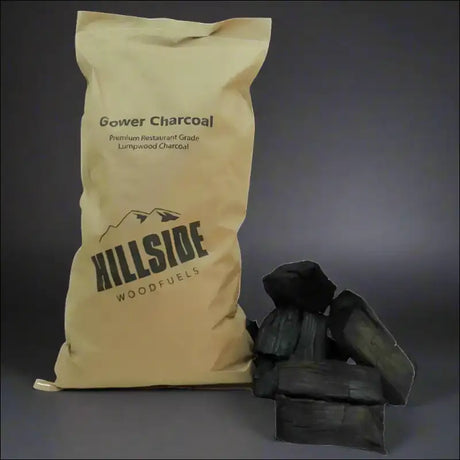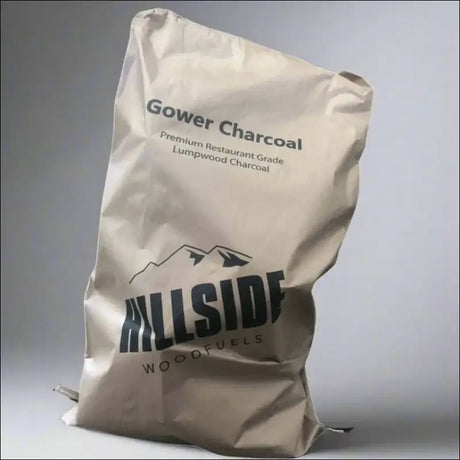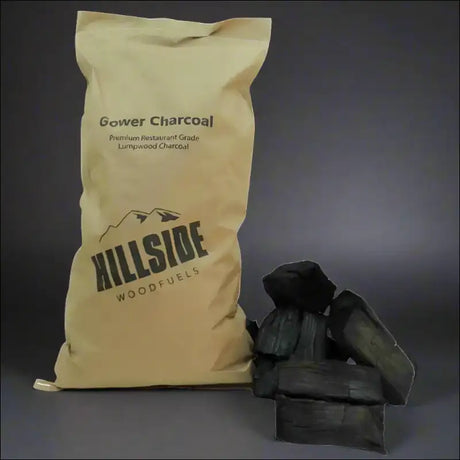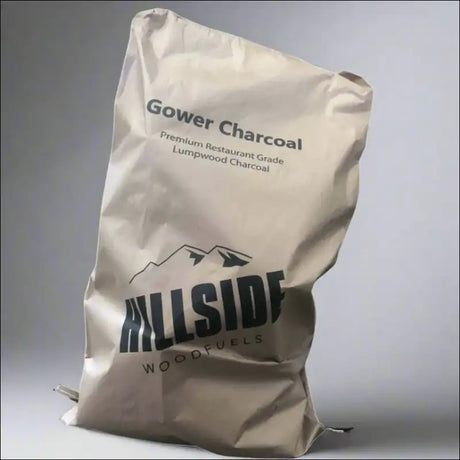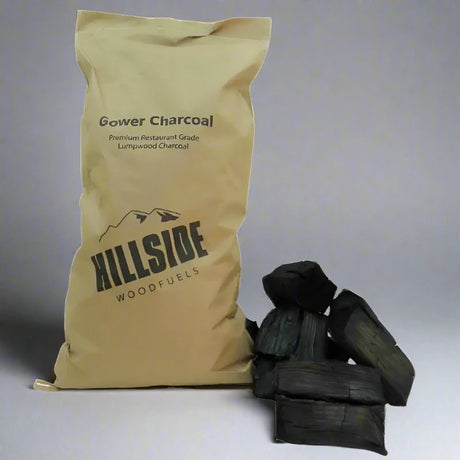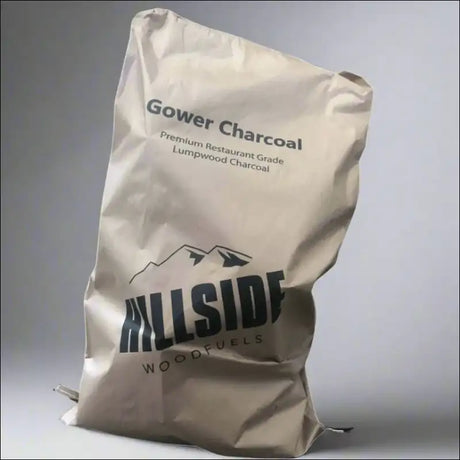Choosing the Right Charcoal and Wood for Your Smoker
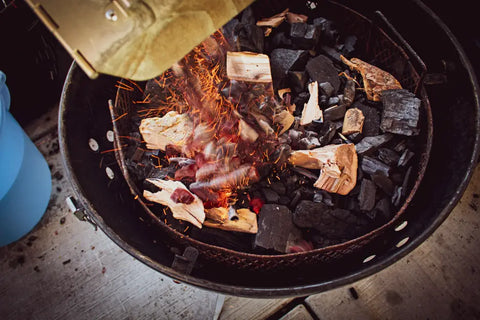
Understanding Lump Charcoal vs. Briquettes
When you're gearing up for a smoking session, the choice between lump charcoal and briquettes is crucial. Lump charcoal, often referred to as lumpwood charcoal, lights up quickly and burns hotter, giving you a searing temperature that's perfect for grilling. On the other hand, briquettes are known for their consistent burn rate, making them ideal for extended smoking sessions.
Restaurant grade lumpwood charcoal is a premium choice for those seeking high heat and a clean burn. It's made from hardwood and contains no additives, ensuring your food gets a natural smoky flavor.
- Lump Charcoal: Quick lighting, burns hot, ideal for grilling.
- Briquettes: Consistent burn rate, suitable for long smoking sessions.
Remember, the key to a successful smoke is not just the type of wood or charcoal, but how you manage the fire. Temperature control and airflow are paramount in achieving that perfect smoky taste.
Selecting Quality Wood Chunks for Flavor
When it comes to smoking, the choice of wood chunks is as crucial as the selection of meat. Quality wood chunks provide not only the heat but also the essential flavors that infuse your food. Look for wood that is free from chemicals and hasn't been treated with any additives. The best wood chunks come in a variety of sizes, allowing you to tailor the smoke intensity and duration to your specific needs.
Variety in chunk size is key for a balanced smoke. Larger pieces burn slowly and impart flavor over a longer period, while smaller chunks tend to burn faster, providing a quick burst of smoke. This mix ensures that your food receives a consistent smoke profile throughout the cooking process.
Remember, the goal is to complement the natural flavors of your food, not to overpower them. Choose wood chunks that will harmonize with your chosen protein and desired taste.
Here's a quick guide to some popular wood chunk options and their flavor profiles:
- Hickory: Robust and smoky, ideal for pork and ribs
- Apple: Mild and sweet, perfect for poultry and seafood
- Cherry: Slightly sweet and fruity, great for all meats
- Maple: Subtle and sweet, best suited for vegetables and cheese
Always ensure that your wood chunks are stored in a dry place to maintain their quality and readiness for your next smoking session.
The Importance of Wood and Charcoal Compatibility
When you're ready to elevate your BBQ game, understanding the synergy between lump charcoal and wood chunks is crucial. Start with quality charcoal and wood, as they are the foundation of your flavor profile. Lump charcoal, known for its ability to burn hot and fast, pairs well with hardwood chunks that can withstand high temperatures without burning out too quickly.
Here's a simple guide to ensure compatibility:
- Use hardwood lump charcoal for a cleaner, hotter burn.
- Match wood chunks to your protein; hickory for pork, apple for chicken.
- Consider the burn time; longer cooks benefit from larger chunks.
Embrace the process and remember that the right combination of wood and charcoal can transform a good BBQ into an unforgettable culinary experience.
Lastly, monitor your temperature closely and adjust vents for airflow control. This balance of heat and smoke will infuse your meats with a depth of flavor that only comes from the perfect match of wood and charcoal.
Mastering the Art of Smoke: Techniques and Tips

Temperature Control and Airflow Management
Achieving the perfect balance of heat and smoke in your smoker is crucial for that restaurant-quality grilling experience at home. Start by selecting high-quality lump charcoal, which burns hotter and faster, allowing you to sear meats at high temperatures before lowering the heat for slow cooking. Here's a simple guide to help you manage temperature and airflow:
- Monitor your temperature closely using a reliable thermometer.
- Adjust the vents to control airflow and stabilize the cooking temperature.
- Add wood chunks sparingly to avoid overpowering your food with smoke.
Remember, patience is key. Allow the smoker to reach the desired temperature before adding your food. This ensures a consistent cooking environment and prevents drastic temperature fluctuations that can affect the outcome of your dish.
Consistent temperature and controlled airflow are the cornerstones of successful smoking. Master these, and you're on your way to creating flavors that rival the best smokehouses.
Understanding the behavior of your smoker, whether it's a reverse-flow or a standard model, will help you maintain the right conditions throughout the cooking process. Experiment with different vent positions and note the results. Over time, you'll develop an intuition for how your smoker responds to changes, leading to more predictable and delicious results.
Balancing Smoke Intensity with Different Woods
When you're aiming for the perfect smoke, the intensity and flavor profile are key. Start by selecting quality charcoal and wood chunks, as these are the foundation of your smoke. Lump charcoal, known for its ability to burn hotter and faster, pairs well with thicker wood chunks that impart flavor gradually. This balance ensures a consistent smoke that doesn't overpower your food.
To manage the smoke intensity, consider the size of the wood chunks. Larger pieces burn slower, offering a sustained smoke, while smaller chunks provide a quicker burst of flavor. Here's a simple guide to help you choose the right size for your needs:
- Small chunks: Quick smoke, intense flavor
- Medium chunks: Balanced smoke, moderate flavor
- Large chunks: Long-lasting smoke, subtle flavor
Remember, the goal is to complement the food, not to compete with it. Adjust your airflow and monitor the temperature to maintain the right amount of smoke. Embrace the process, and don't be afraid to experiment with different wood types to find your ideal smoke profile.
Customizing Your Smoke Profile with Wood Blends
Crafting the perfect smoke profile for your barbecue can be as creative as cooking itself. By blending different wood chunks, you can tailor the aroma and taste to your liking. Start by considering the intensity of the flavors you enjoy. Hickory, with its robust smoky flavor, is excellent for pork and beef, while fruit woods like apple and cherry offer a milder, sweeter note suitable for poultry and fish.
- Hickory: Intense, smoky flavor - ideal for pork and beef
- Apple: Mild, sweet flavor - great for poultry and fish
- Cherry: Mild, sweet, and fruity - perfect for poultry and fish
- Mesquite: Strong, earthy flavor - pairs well with dark meats
Experiment with these combinations, or create your own custom blends to discover what works best for you. Remember, the size of the wood chunks can affect the burn time and, consequently, the flavor imparted. A mix of sizes can provide a more complex flavor profile over the duration of your cook.
Embrace the art of smoking by adjusting the blend to match the protein and desired smoke level. Keep in mind that wood chunks should be kept dry and fresh to maintain their quality and readiness for your next barbecue adventure.
The Long Cook: Maximizing Flavor Over Time

Choosing Wood Chunks for Extended Smoking Sessions
When planning for extended smoking sessions, selecting the right wood chunks is crucial for maintaining a consistent smoke and flavor. It's essential to balance the size of the wood chunks to ensure they burn at the right pace. Larger chunks tend to burn slower and are ideal for long cooks, while smaller pieces may be used to adjust the smoke intensity as needed.
Here's a quick guide to help you choose the right wood chunk size for your smoking session:
- Large Chunks (2 x 3 inches): Ideal for long-lasting smoke and a steady release of flavor.
- Medium Chunks: Offer a balance between longevity and quicker smoke development.
- Small Chunks: Burn faster, suitable for adding a burst of smoke or for shorter sessions.
Remember, the goal is to create a cozy winter atmosphere, not just to prepare firewood. The right wood chunks will impart their flavor over time, enhancing the taste of your smoked meats. Experiment with different sizes and types of wood to find the perfect match for your smoker and the proteins you're cooking.
Consistency is key in extended smoking. Aim for wood chunks that provide a steady smoke output without the need to frequently open the smoker and disrupt the temperature.
Pairing Wood Chunks with Proteins for Optimal Taste
When it comes to smoking meats, the right combination of wood chunks and proteins can make all the difference. For a robust, smoky flavor, consider using hickory wood chunks, which are especially suited for pork and beef due to their intense flavor profile. Here's a simple guide to help you pair wood chunks with various proteins:
- Pork: Hickory, apple, or cherry wood chunks
- Beef: Hickory, mesquite, or oak wood chunks
- Poultry: Apple, cherry, or pecan wood chunks
- Fish: Alder, apple, or cherry wood chunks
Remember, the size of the wood chunks can affect the duration and intensity of the smoke. Larger chunks tend to burn slower, providing a sustained smoke that's ideal for long cooks. On the other hand, smaller pieces may burn quickly, offering a burst of flavor that's perfect for shorter grilling sessions.
To truly elevate your grilling experience, don't shy away from experimenting with different sizes of wood chunks. This allows for a more controlled flavor infusion, ensuring that your meats are not only cooked to perfection but also imbued with a depth of flavor that only natural wood smoke can provide.
Lastly, always keep your wood chunks fresh and dry. Storing them properly will ensure they're ready to use when you are, contributing to a clean burn and easy cleanup after your smoking session.
Maintaining Consistent Smoke Throughout the Cook
To ensure your barbecue is infused with that perfect smoky flavor from start to finish, it's crucial to maintain a consistent smoke level. Begin by selecting premium charcoal; it's the foundation for a stable and long-lasting burn. Light your charcoal carefully and aim for a 'low and slow' approach, which is essential for extended smoking sessions.
Monitor your smoker's temperature closely. Adjust the vents to control airflow and keep the temperature within the ideal range. Remember, lump charcoal burns hotter, so you may need to regulate it more often than briquettes.
Consistency is key. By knowing your woods and how they interact with different proteins, you can maintain the right smoke intensity throughout the cook.
Here's a simple checklist to keep you on track:
- Light charcoal efficiently to avoid fluctuating temperatures.
- Know your woods and their burn rates.
- Focus on natural flavors by avoiding lighter fluids or artificial additives.
- Maintain your smoker properly to prevent unexpected issues.
By following these steps and paying attention to the details, you can achieve restaurant-quality results in your backyard BBQ.
Maintaining Your Smoking Ingredients
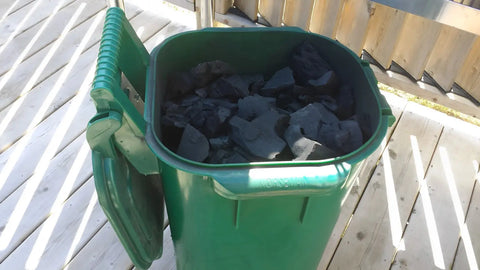
Storing Wood Chunks for Freshness and Readiness
To ensure your wood chunks are always at their best for smoking, proper storage is key. Start by selecting a dry, cool place away from direct sunlight to prevent any moisture from seeping in. Moisture is the enemy of wood chunks, as it can lead to mold growth and a less efficient burn. Consider using a dedicated storage container, like the Oklahoma Joe's Pellet Bucket, to keep your wood chunks dry and organized.
When storing, it's also beneficial to sort your wood chunks by size. Having a variety of chunk sizes allows for a controlled burn and a steady release of flavor. Larger pieces will burn slower, providing a consistent smoke over a longer period, while smaller pieces catch quickly, offering an initial burst of flavor. This variation ensures that your food receives a complex and layered smoke profile.
Remember, the goal is to maintain the integrity of your wood chunks. By keeping them in optimal condition, you're not just preserving their physical state but also the potential for exceptional flavor they can impart to your food. Lumpwood charcoal, paired with well-preserved wood chunks, offers controllable heat and long burn times, enhancing the taste and quality of your smoked dishes.
Keeping Charcoal Dry and Easily Accessible
Ensuring your lump charcoal remains dry is crucial for maintaining its quality and ease of ignition. Store your charcoal in a cool, dry place away from moisture. A metal bin with a tight-fitting lid can prevent humidity from affecting the charcoal. To keep your charcoal easily accessible, consider using a storage container with wheels or a handle for portability, especially if you often move your smoking setup.
- Keep charcoal in a sealed container
- Store in a cool, dry location
- Use a container with wheels for easy movement
By taking these simple steps, you'll be ready to start smoking at a moment's notice, with charcoal that lights quickly and burns consistently.
Remember, the condition of your charcoal can significantly impact the quality of your smoke. Regularly check your stock and replenish it as needed to ensure you always have fresh charcoal on hand. This will help you avoid the frustration of damp charcoal that struggles to light or burns poorly, which can ruin the smoking experience.
Cleaning Up: Dealing with Ash and Residue
After a satisfying smoking session, it's crucial to address the aftermath in your smoker. Ash and residue, if not managed properly, can affect the performance and longevity of your equipment. Here's a simple guide to keeping your smoker in top condition:
- Empty the ash: Once the smoker has cooled, carefully remove the ash. A metal bucket or ash tool can be helpful for this task.
- Inspect for residue: Check for any grease or food particles. These can attract pests and cause unpleasant odors.
- Clean grates and surfaces: Use a grill brush or scraper to clean the grates. For stubborn residue, a mixture of vinegar and baking soda can be effective.
- Dispose of ash responsibly: Ash can be beneficial for compost or garden use, but ensure it's completely cool before disposal.
Maintaining a clean smoker isn't just about aesthetics; it's about ensuring the integrity of your next smoking experience. Regular cleaning prevents buildup that can interfere with temperature control and smoke flow.
Remember, a well-maintained smoker is a reflection of the care you put into your craft. By following these steps, you'll be ready for your next session with a smoker that's as good as new.
Innovative Smoking with Pellet Smokers

The Benefits of Using Pellet Smokers for Smoking
Pellet smokers offer a unique combination of convenience and flavor that can elevate your smoking game. Unlike traditional charcoal smokers, pellet smokers use an electronic system to maintain consistent temperatures, which means you can enjoy a more hands-off cooking experience without sacrificing the smoky taste that comes from using wood as fuel.
With a pellet smoker, you're getting the best of both worlds: the ease of an electric smoker and a flavor profile that's closer to a charcoal smoker.
Here are a few key benefits of using pellet smokers:
- Consistent cooking temperatures for even smoking
- The convenience of a set-it-and-forget-it approach
- A variety of wood pellet flavors to choose from
- Less mess and easier cleanup compared to charcoal
If you're planning a long smoke session, consider a pellet smoker with a large-capacity hopper or keep extra pellets on hand to ensure you don't run out. Remember, the key to a successful smoke is not just the equipment but also the quality of your ingredients and your attention to detail throughout the cooking process.
How to Combine Pellets with Lump Charcoal and Wood Chunks
Combining pellets with lump charcoal and wood chunks can elevate your smoking game to new heights. Start by selecting high-quality lump charcoal, known for its superior airflow and quick heating capabilities. Add wood chunks to introduce a desired smoky flavor and ensure a long burn life, perfect for extended smoking sessions.
- Begin with a base of lump charcoal for a hot and efficient fire.
- Introduce wood chunks of varying sizes to control the release of smoke and flavor.
- Add food-grade pellets to enhance the taste of your chosen protein or vegetables.
Remember, the key to a successful blend is balance. You want the intense heat from the lump charcoal to sear and cook efficiently, while the wood chunks and pellets provide a layered smoky flavor. Monitor the temperature and adjust your smoker's vents to maintain the perfect smoking environment.
By mastering the combination of these three elements, you can create a customized smoke profile that complements your food perfectly, without overpowering it.
Creating Custom Flavor Profiles with Pellet Blends
Unlock the full potential of your pellet smoker by creating custom flavor profiles that cater to your palate. Start by experimenting with the top producers of gourmet lump charcoals from regions like Mexico, USA, and Indonesia, each offering unique flavors such as hickory and various fruit woods. Here's how to get started:
- Begin with a base of high-quality pellets, ensuring they are 100% natural for a clean burn and minimal ash.
- Introduce wood chunks with complementary flavors, like hickory for its intense, smoky taste, ideal for pork and beef.
- Customize further by mixing different wood chunks or pellets to match the protein you're cooking. Darker meats pair exceptionally well with robust woods.
Keep your wood chunks and pellets fresh and dry. Store them in a container like the Oklahoma Joe's Pellet Bucket for optimal readiness.
Remember, the key to a successful smoke is balance. Your goal is to enhance, not overpower, the natural flavors of your food. With a little practice, you'll be able to craft a smoke profile that's uniquely yours.
Conclusion
Mastering the art of smoking with lump charcoal and wood chunks is a journey that rewards patience and experimentation. By starting with high-quality charcoal and wood, monitoring temperatures closely, and adjusting airflow, you can achieve the perfect balance of heat and smoke. Whether you're using a charcoal smoker or a grill, the combination of lump charcoal with wood chunks like hickory or mesquite offers a game-changing flavor profile. Remember to mix and match wood flavors for custom blends and utilize different chunk sizes for a more nuanced smoke infusion. With these tips and the right equipment, such as Oklahoma Joe's Wood Smoker Chunks, you're well on your way to elevating your grilling game and impressing guests with your smoky culinary creations.
Frequently Asked Questions
What are the differences between lump charcoal and briquettes?
Lump charcoal is made from pure wood and tends to burn hotter and faster, providing a more natural flavor. Briquettes are manufactured from compressed charcoal dust and other additives, offering a more consistent burn rate and longer burn time.
How do I select the best wood chunks for smoking?
Choose high-quality, all-natural wood chunks that are appropriate for the protein you're smoking. Different woods impart different flavors; for instance, hickory is ideal for pork and beef due to its intense smoky flavor.
How can I maintain the right temperature and airflow in my smoker?
Monitor the temperature closely and adjust the smoker's vents to control airflow. This helps maintain a steady temperature for optimal smoking conditions.
Can I mix different wood chunks to create custom smoke profiles?
Absolutely! Mixing different wood chunks allows you to customize the smoke profile to your liking, combining various intensities and flavors for a unique taste.
What are the benefits of using a pellet smoker compared to other types?
Pellet smokers provide the convenience of set-and-forget temperature control, and they can be used to easily create custom flavor profiles by blending different pellet types.
How should I store my wood chunks and charcoal to maintain their quality?
Keep wood chunks in a dry place to ensure they remain fresh and ready to use. Store charcoal in a cool, dry area to keep it dry and easily accessible. Both should be stored away from direct sunlight and moisture to prevent spoilage.



